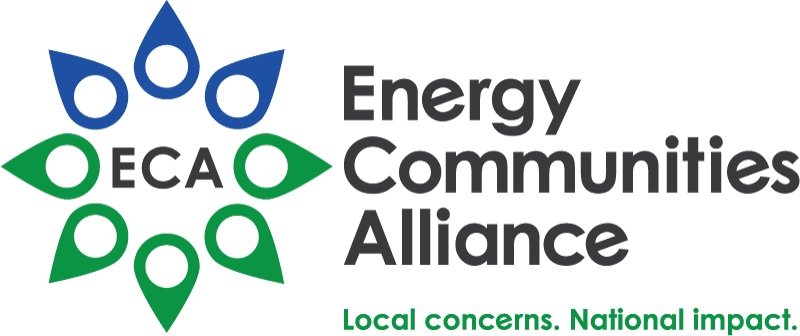EXPLORING THE FUTURE OF NUCLEAR ENGINEERING AT MICHIGAN: LESSONS FOR ENERGY COMMUNITIES
Exploring the Future of Nuclear Engineering at Michigan: Lessons for Energy Communities
A recent visit to the University of Michigan’s Department of Nuclear Engineering & Radiological Sciences (NERS) by ECA’s Laura Hermann received a vivid preview of what the next generation of nuclear leaders will accomplish — and how university work connects directly to the priorities of Energy Communities Alliance (ECA) members.
As a featured speaker for the department’s monthly series, Laura shared the recommendations from ECA’s latest publication, “From the Atomic Age to New Nuclear” and talked about efforts to facilitate community dialogue as investments in social trust. But the day offered so much more than an audience interested in learning more about ECA.
Speed Dating at NERS
The Department offered a warm welcome for the Halloween visit and filled the day with a variety of meet-and-greets. A coffee chat with members of the Women in Nuclear (WIN–NERS) chapter allowed for casual conversations about experiences navigating an ever-evolving industry and building supportive professional networks. Dr. Katie Snyder took interest in how elected officials communicate in the age of misinformation and social media while she shared her approach to teaching technical communication in the engineering program. A discussion with Professor Kim Kearfoot and a visiting faculty member from a university in Rwanda addressed advancing health physics education in Africa. Their work highlighted how radiation protection and safety culture are adapted to regional contexts, in this case, in a country with mining driving the need for health physicists. Naturally occurring radioactive materials is accumulating in dangerous amounts due to Rwanda’s columbite-tantalite industry - a mineral mined and refined for use in cell phones and other electronics.
The discussions drove home how important it is to maintain local expertise for environmental management and long-term stewardship of nuclear materials even where no nuclear facilities exist. For ECA members, this perspective highlights how international capacity building and cross-disciplinary training share intersecting goals: ensuring communities have the scientific foundation to make informed decisions about radiation and cleanup and confirming technology specialists have the communication skills to share relevant information effectively.
Immersed in the Future, Virtually
In the Visualization Lab, former game designer Sara “Dari” Eskandari demonstrated how immersive virtual environments are being used to model both fission and fusion systems. The lab’s virtual worlds help students — and visitors like Laura — do virtual walk-throughs of the magnetic confinement in ITER and designs for remote SMR installations. NERS uses these visualization tools not only in the classroom but also in outreach settings to build nuclear literacy among community members and decision-makers. As technology like META’s Quest Virtual Reality headsets get more affordable and portable, we anticipate getting these into the hands of ECA’s local governments. Such visualizations are powerful tools for explaining complex systems like spent fuel storage or microreactor deployment in a transparent and accessible way.
Graduate Research with Community Relevance
A series of conversations with NERS graduate students revealed how academic research increasingly intersects with the priorities of DOE sites and host communities:
• Riley Fisher is developing a first-of-its-kind comprehensive dataset mapping all nuclear fuel cycle sites across the United States — examining patterns of siting and their demographic impacts. Her work provides a foundation for understanding environmental justice considerations and legacy facility distribution, key issues for ECA members engaged in siting discussions.
• Tanmay Deshmukh is mapping existing data centers nationwide and conducting case studies in 22 counties to assess the potential for powering digital infrastructure with nuclear energy. His findings bridge the gap between advanced nuclear development and the clean-energy demand from data center growth — an emerging opportunity for energy communities.
• Md Rafiul Abdussami is performing operational analysis on retrofitting retiring coal plants with both light-water and advanced reactors. His work directly aligns with DOE and ECA initiatives to repurpose brownfield sites and preserve high-value grid infrastructure while creating new local employment.
• Diana Cambero Inda presented results from a participatory design workshop on microreactors, revealing public preferences and perceptions of safety, scale, and visual design. This type of social research offers valuable insight into how communities might approach consent-based siting or design discussions around future small-scale nuclear projects.
Together, these projects demonstrate how the engineering programs are integrating technical excellence with social awareness — a combination increasingly essential for successful nuclear deployment. NERS faculty and students are not only advancing science; they are reimagining how nuclear knowledge is created, shared, and applied. Their work aims to create a future where technical innovation and community engagement evolve together.
For Energy Communities Alliance members, partnerships with institutions like the University of Michigan offer more than academic collaboration — this visit demonstrated the practical value and opportunity inherent in aligning national research with on-the-ground decision-making.
